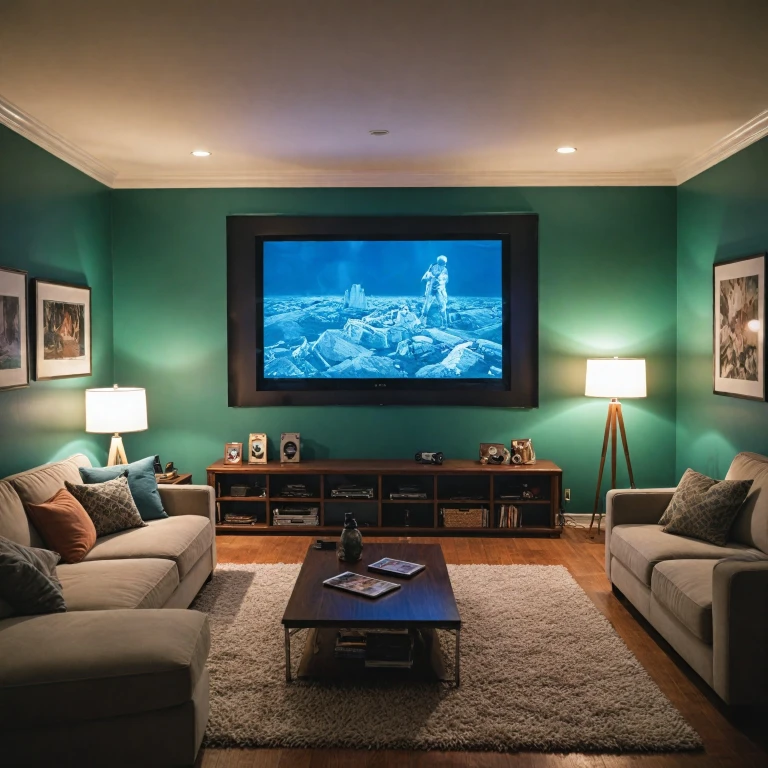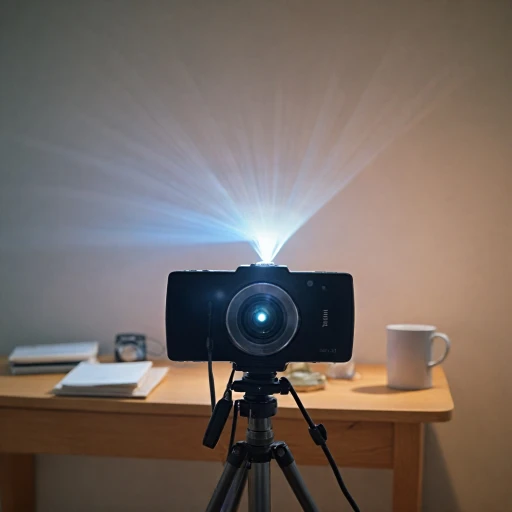Understanding Projector Compatibility
Making Sense of Projector Compatibility
If you're looking to enjoy the myriad possibilities a home theater projector offers with your phone, understanding compatibility is a crucial first step. Before diving into the specifics of connecting your smartphone, it's essential to identify the key components that dictate compatibility: the type of projector, the operating system of your phone, and the available ports on both devices. Modern projectors come with various connection options like HDMI, USB, and some even support wireless connections via Bluetooth or Wi-Fi. To connect your iPhone or Android phone to a projector, verify what kind of ports your projector supports—whether it's HDMI ports, USB ports, or the ability to project wirelessly. Similarly, check your smartphone’s specifications for screen mirroring and connection compatibility. It's important to have the right adapters and cables such as a USB HDMI adapter or an HDMI cable if you're opting for a wired connection. Note that some projectors support direct USB connections, turning them into a smartphone projector with the simple insertion of a USB cable. Moreover, ensure that your projector and phone both support screen mirroring if you're looking at wireless options. Devices such as Chromecast can facilitate this, allowing content from your phone screen to be displayed seamlessly. In the next stages, we’ll explore how to connect your device using both wired and wireless methods, while troubleshooting common issues and optimizing your viewing experience along the way. The user manual of your projector or phone often provides valuable information on connection compatibility, making them handy resources as you set up your ideal home theater viewing experience.Choosing the Right Connection Method
Evaluating Connection Methods for Your Projector
When it comes to connecting your phone to a home theater projector, selecting the right connection method is crucial for a seamless experience. The choice largely depends on your projector's compatibility and the available ports on your devices. Here's a breakdown of the most common methods to help you make an informed decision.
Wired Connections
- HDMI Connection: Most modern projectors feature an HDMI port, making it a popular choice for connecting phones. To connect your smartphone, you may need an HDMI adapter or a USB HDMI cable, especially for devices like an Android phone or iPhone.
- USB Connection: Some projectors support a direct USB connection. This method is typically straightforward, requiring a USB cable to connect your phone to the projector's USB port.
Wireless Connections
- Screen Mirroring: Many projectors support screen mirroring via technologies like Chromecast or built-in wireless capabilities. This allows you to project content from your phone without the need for cables.
- Bluetooth: While not as common for video, Bluetooth can be used for audio connections, enhancing your viewing experience when paired with a Bluetooth-compatible projector.
Each method has its pros and cons, and the best choice depends on your specific setup and preferences. For instance, while wired connections might offer more stability, wireless options provide greater flexibility. Consider consulting your projector's user manual or user guide to determine the supported connection methods and choose the one that best suits your needs.
Step-by-Step Guide for Wired Connections
Wired Connection Setup: A Simple Guide
When preparing your home theater projector for a wired connection, you'll want to ensure both the projector and your phone are compatible with the necessary hardware and software. Most modern projectors come equipped with a variety of ports, such as HDMI and USB, that allow for seamless connecting to phones and other devices. Gathering the Necessary Cables and Adapters To get started with your wired connection, you'll first need to make sure you have the appropriate cables and adapters. Here's a quick checklist of what you might need:- HDMI Cable: A standard choice for high-quality video and audio transmission. If your phone supports HDMI output, this is your best bet for crystal-clear display.
- USB Cable: Some projectors and phones offer USB connections for mirroring. This method may require a specific projector USB setup steered by your device's support.
- Adapter: Depending on your phone's port, you might need a USB to HDMI adapter or USB-C to HDMI adapter to facilitate the transfer.
- Turn off both devices for safety before connecting. Make sure your projector is plugged in and ready to power up.
- Connect HDMI Cable: Plug one end of the HDMI cable into the HDMI port on your projector and the other into your HDMI adapter.
- Prepare your Phone: If your phone has a compatible USB-C port, connect your USB-C to HDMI adapter. For older phones, consider a USB HD adapter suitable for your charging port.
- Power On: Once connected, power on your projector first, followed by your phone. This ensures both devices detect the connection properly.
- Switch Input Source: Use the projector's remote or onboard navigation to switch to the appropriate HDMI input source. Your phone screen should begin mirroring on the projector screen.
Setting Up Wireless Connections
Unleashing the Potential of Wireless Connections
In our tech-savvy world, cutting the cords can mean a hassle-free experience when connecting your phone to a projector. Fortunately, there are several methods available for setting up wireless connections with different devices. One of the most popular options for connecting an Android phone is utilizing the built-in screen mirroring feature. This handy tool allows you to wirelessly mirror your phone's content directly to the projector's screen using Miracast or a similar technology. Most modern projectors come equipped with wireless support and can seamlessly integrate with Android devices. Alternatively, for the Apple enthusiasts, connecting an iPhone via wireless means can be achieved with Apple AirPlay. Typically, you'll need an Apple TV connected to the projector via an HDMI port for seamless mirroring. This method ensures that your phone's screen, from apps to streaming services, is projected effortlessly. For those seeking versatility, consider using a Chromecast. This device can be plugged into the projector's HDMI port and is perfect for streaming content from both Android and iOS smartphones. After an initial setup using the Google Home app, you can cast videos and images directly to your projector with a quick tap. Beyond these methods, some projectors even offer built-in Bluetooth connectivity. Check your projector’s user manual or guide to determine if this feature is supported. By pairing your phone with the projector wirelessly, you can easily share content without any fuss of wires. When going wireless, ensure that both your projector and phone are connected to the same Wi-Fi network. This step is critical for establishing a stable connection without hiccups. If you encounter any snags along the way, revisit earlier sections for common troubleshooting tips. Ultimately, wireless connections offer unparalleled convenience, opening up a world of possibilities for entertainment and presentations without the clutter of cables. Embrace the freedom and flexibility of wireless technology to revolutionize your viewing experience.Troubleshooting Common Connection Issues
Resolving Common Issues with Phone Connectivity
Encountering issues when trying to connect your phone to a projector can be frustrating, but fear not. Here are some practical tips to troubleshoot common connection problems and enhance your viewing experience.- Check Your Cables and Ports: Ensure that the USB or HDMI cables are functioning correctly. Sometimes, a simple swap or reseating of an HDMI cable or USB port can effectively resolve connectivity problems. It's also critical to make sure that your projector's HDMI port is operational.
- Confirm Compatibility and Settings: Before diving deeper, ensure the device you're using is compatible with your projector. Each projector model may support different types of connections. Double-check that the correct input source is selected on the projector.
- Fiddle with Resolution Settings: If the screen mirroring doesn’t deliver the visual quality expected, try adjusting the resolution settings on the phone and projector. Some phones and projectors automatically adjust the resolution, but occasionally manual adjustments are needed.
- Examine Wireless Connections: For Bluetooth connections, ensure both devices are in pairing mode and within range. If using Chromecast or wifi for mirroring, double-check that both the phone and projector are connected to the same network.
- Update Software and Firmware: Outdated firmware on your projector or phone can cause hitches in connections and presentations. Regularly check for updates on both devices to ensure they function seamlessly during mirroring.
- Reference Manufacturer's Support Resources: The user manual or online support provided by the manufacturer can offer valuable insights. Consult these guides for specific troubleshooting tailored to your projector's make and model.
Optimizing Your Viewing Experience
Enhancing the Quality of Your Projection Experience
To truly make the most out of your home theater projector, optimizing the viewing experience is key. Follow these helpful tips to elevate how your device performs:- Adjust Screen Size and Distance: Ensure that your phone's content fits well on the projector screen by correctly aligning the distance between the projector and the screen. This can often be referenced in the user guide or manual provided with your projector.
- Choose the Right Projection Surface: The surface on which you project can drastically impact image clarity. A smooth, white wall or dedicated projector screen is ideal. Avoid using textured or colored surfaces as they can distort the image.
- Calibrate Your Projector's Settings: Spend some time tweaking the projector's brightness, contrast, and color settings to suit your viewing environment's lighting. Adjustments can help in achieving vibrant and clear visuals whether you're using an HDMI, USB, or wireless connection.
- Optimize Your Device's Display Settings: If you're using a smartphone projector configuration, ensure the display settings on your device are optimized for mirroring. Many Android phones and iPhones have specific settings for screen mirroring that enhance picture quality.
- Utilize High-Quality Cables and Adapters: Whether you're connecting via HDMI cable or USB adapter, using quality components ensures a stable and secure connection, minimizing lag or interruptions in image delivery.
- Enhance Wireless Connections: For setups utilizing Bluetooth or Chromecast, ensuring a robust Wi-Fi network reduces buffering times and improves the overall fluidity of your wireless stream.
- Regular Maintenance: Clean your projector’s lens regularly to avoid dust and dirt buildup, which can obscure or blur the projected image. Regularly check the projector's firmware for updates to improve functionality and compatibility.



